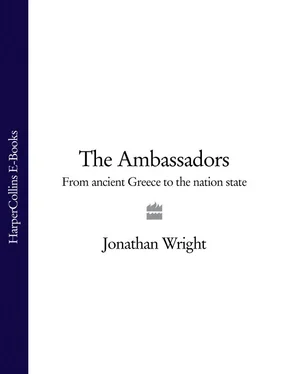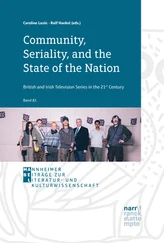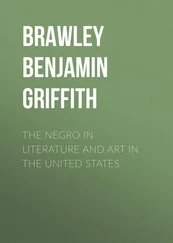A few days further into their journey, the ambassadors encountered a local viceroy, and he was just as determined to provide lavish hospitality. Once again, the ambassadors were ridiculously well fed. To the accompaniment of ‘organs, fiddles, Chinese fifes and two types of flute’, they dined on musk melons and watermelons, ‘walnuts, peeled chestnuts, lemons, garlics, and onions pickled in vinegar’. The feast was rounded off by an acrobatic display, with tricks being performed by ‘handsome boys, with their faces painted red and white in such a way that whoever happened to look at them took them for girls, with caps on their heads and pearls in their ears’.
Festivities followed in every town through which the ambassadors passed until, in mid-December, they arrived in Peking. News reached the envoys that the emperor himself was planning a lunchtime banquet. They rode from their lodgings to the imperial palace and, having dismounted at the first gateway, they were ‘conducted to the foot of the throne’ and ‘made prostration to the emperor five times’. Led from his presence, the ambassadors were now advised to seek out a toilet, ‘lest they should unexpectedly feel the necessity to rise in the middle of the banquet for some need when it would not be possible to go out’.
With such matters attended to, the ambassadors returned to the scene of the banquet, ‘a very extensive courtyard paved most beautifully and exquisitely with cut stones’. Inside a canopy they discovered a ‘magnificent throne, higher than the height of man with silver staircases on its three sides’. Incense burners and eunuchs were posted on either side, and next to them ‘stood stalwart Chinese officers armed with quivers’. Further back came ‘soldiers with long halberds in their hands and behind them yet another body of men with drawn swords’.
The Yongle emperor made his entrance and took his seat beneath a canopy of yellow satin decorated with images of fighting dragons. All was silence as the ambassadors, ‘on the tiptoe of expectation’, approached the throne. Once they had prostrated themselves five more times, the meal got under way. There were yet more acrobats – a troupe of dancers, made up of boys ‘as beautiful as the moon’ – and with the arrival of each new course an orchestra struck up and an ocean of coloured umbrellas were spun around. With the meal of lamb, goose and rice wine complete, the emperor doled out rewards to the performers and retired
to his harem. 7
The Persian ambassadors had been treated with the greatest courtesy, but the Chinese did not perceive them as representatives of a political equal. From the earliest days of imperial China in the second millennium bc, whenever envoys came to China, whether from Persia, Rome or the courts of Europe, they were seen as the bearers of tribute and homage to the greatest ruler in the world. Such visits flattered the emperor, they were a fitting sign of respect and submission, and it behoved the Chinese court to respond with grace and generosity.
But all the world over, and certainly not only in China, diplomacy has always been a game of power and one-upmanship. When an insult was called for, rulers would turn to less than impressive individuals to serve as their envoys. Louis XI of France once sent a barber on a diplomatic errand to Margaret of Burgundy; another French king disparaged Edward III of England by conveying a message of defiance via a kitchen hand; the citizens of ancient Rhodes were furious when Rome supplied an ambassador who not only lacked the customary rank of senator but was also a lowly gymnastics instructor.
Conversely, when one ruler wished to show respect to another he would select skilled, very often noble, ambassadors, and kings and princes have usually interpreted the arrival of such men as a reflection of their own grandeur. The Roman emperor Augustus would boast of how ‘embassies were sent to me from the kings of India who had never been seen before in the camp of any Roman general’. 8 One of Elizabeth I’s more devoted subjects reported how English sailors refused to transport Moroccan ambassadors in 1600, ‘because they think it is a matter odious and scandalous to the world to be too friendly or familiar with infidels’. Nevertheless, it remained ‘no small honour to us that nations so far remote and every way different should meet here to admire the glory and magnificence of our Queen of Sheba’. 9
China, being no different, was always pleased to receive envoys. Despatching ambassadors of its own was an infinitely more troubling proposition, however. Would it not be a sign of weakness or of parity with the barbarian hordes beyond its borders? Often, China decided that it would – but, to return to the ancient world at last, sometimes it did not.
There have been many epic diplomatic journeys. The distances travelled and the time such journeys took are apt to bewilder the modern reader. Envoys sent from ancient Babylon to Egypt traversed thousands of miles of caravan routes, usually only covering forty or fifty miles a day. When the ambassadors of an Indian king sought out the Roman emperor Augustus in 20 BC their outward journey lasted more than four years – a respectable achievement given the curious cargo with which they were burdened: a serpent ten cubits long, a partridge larger than a vulture, and an armless youth who could play the trumpet with his feet. 10 The journey of the Han ambassador Chang Ch’ien was every bit as impressive.
The Han dynasty ruled China, a seventeen-year hiatus excepted, from 206 BC to ad 220. It was a civilization that easily bears comparison with either fourth-century Athens or Mauryan India. Paper was invented, ideologies were forged, and a fiercely efficient bureaucracy was developed. Specialized, well-trained ministers oversaw everything: whether tax collection, religious ceremonial or the observation of the stars. The market places of the Han capital, Ch’ang-an (modern Xi’an), bustled with merchants from across Asia; Buddhist missionaries travelled throughout the empire; and the Han embraced a policy of expansion and discovery. Their armies penetrated south of the Yangtze River, eastwards to Korea, and even into the mysterious ‘western regions’ of central Asia. China was no less assured of its plenitude, but it was open to the world.
The Han emperor had many enemies, notably the aggressive Hsiung-nu tribe on China’s northern frontier. Traditionally, it had seemed more sensible to contain the Hsiung-nu threat than to engage them in battle. Supplying them with luxurious goods – offering them bribes, in effect – also served to blunt their hawkish tendencies. One Han courtier talked of the various ‘baits’ with which the Hsiung-nu could be seduced: ‘to give them elaborate clothes and carriages in order to corrupt their eyes; to give them fine food in order to corrupt their mouths; to give them music and women in order to corrupt their ears; to provide them with lofty buildings, granaries and slaves in order to corrupt their desires’. 11
The Han emperor Wu-ti grew weary of this passive, and to his mind ignoble, variety of diplomacy. He decided it was time to join battle with the Hsiung-nu. He would require allies, and who better than a people known as the Yueh-shih? They had been defeated by the Hsiung-nu and forced into exile, though not before the skull of their king had been fashioned into a drinking cup. They would surely crave revenge. Unfortunately, no one knew where they had fled. And so, in c.140 BC, the courtier Chang Ch’ien was despatched as an ambassador to locate their whereabouts.
A man of strong physique and of considerable generosity, Chang was accompanied by a hundred attendants as he set out on his embassy but he was almost immediately captured by the Hsiungnu. He spent the next ten years in captivity, although he seems to have been treated decently, and even acquired a Hsiung-nu wife and son. Finally, he managed to escape and embarked on a journey that would take him further west than any previous Chinese ambassador. He even located the Yueh-shih in present-day Kazakhstan, only to find they had no interest in forging an alliance with the Han. Chang spent the next year travelling around the region. On his homeward journey he was again captured by the Hsiung-nu but quickly escaped and reached the Chinese court in 126 BC. Only two of the hundred servants who had originally set out returned alive.
Читать дальше












